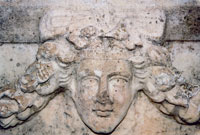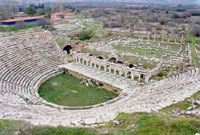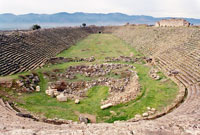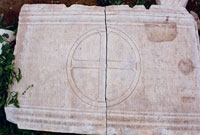
|

|
 |
|
Aphrodisias enjoys both an unbelievable historical richness and a
beautiful natural scenery where all green tones from poplar to olive trees
are present. The city was famous not only as a philosophy and medicine
center but above all as a school of sculpture: the masterpieces realized
there have been spread all over the Roman Empire and found back in the
most popular temples such as in
Didyma. |
|
|
Aphrodisias was a Carian town named after the goddess of beauty and love,
Aphrodite, whose origins date back from the Hittite and Phrygian cultures.
Lots of Aphrodite's characteristics are similar to those of the
Ephesus Artemision but cannot be compared with the Greek
Aphrodite. Aphrodisias knew her golden years during the Roman period as it
was located alongside a main trade road. |
|
 |
|
 |
|
Even
after the upcoming of Christians, Aphrodisias remained an important pagan
center. Under the Byzantines, who renamed it "Stavropolis" (Town of the
Cross), Aphrodisias became the residence of the bishop of Caria. When
Aphrodisias had been conquered by the Turks, it received its current name
"Geyre", most probably a deformation of "Caria". |
|
|
Today Aphrodisias is not only visited for its beautiful site but also for
its opulent sculpture museum. During the 35 years continuous excavations,
the temple of Aphrodite, the amphitheater, the thermal baths with their
inlaid marble floors, the agora and the stadium, one of the best preserved
and biggest in the world, have been brought to daylight. |
|
 |
|
|
|
|
|
 Rated: 9.8
out of 10
by 343
Reviews
Rated: 9.8
out of 10
by 343
Reviews
|
|
|
Pages |
Ads |
|
|
|
|




